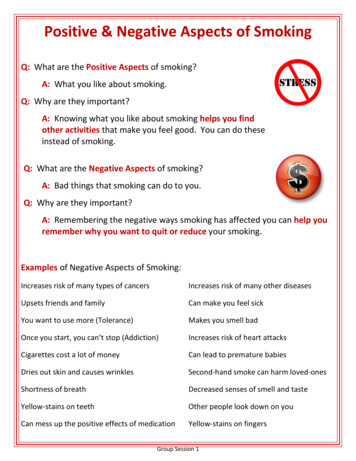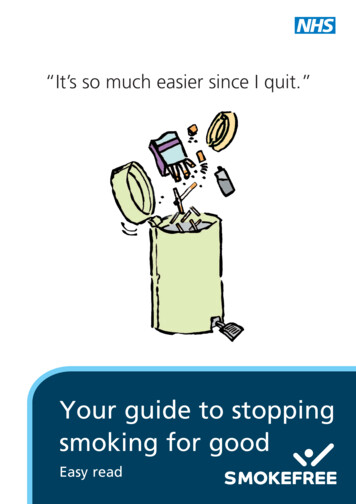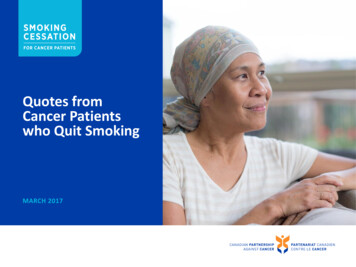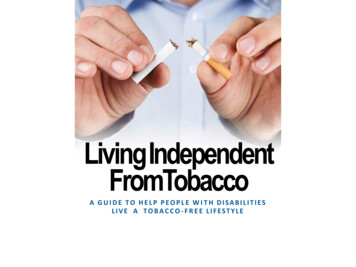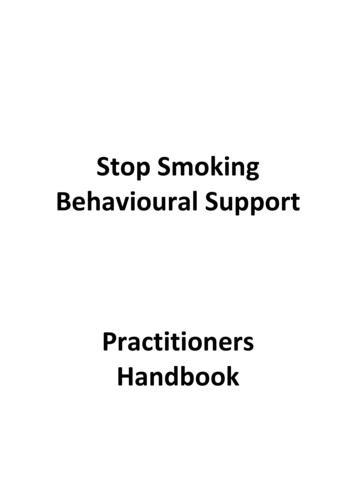
Transcription
The End of SmokingA brief guide for local authority members and officersand their partners on Health and Wellbeing Boards1
Win-win-win-winThe smoking epidemic continues to cause immense harm to individuals, familiesand communities throughout England. Smoking kills, impoverishes, and ratchets upinequalities.But none of this need be the case. The smoking epidemic is the product of humaningenuity: a toxic synthesis of technology and mass marketing. And just as we createdthis epidemic, so we can end it.Local authorities are in the front line. Working with their partners and communities, localauthorities can define the vision and strategy to deliver a smokefree generation, the firstin hundreds of years.The community dividends of a fully-fledged tobacco control strategy are huge as theeffects of smoking on communities are so great. Tackle smoking effectively and you will: lift thousands of households out of povertyincrease local productivity and economic prosperityprotect children from harmreduce inequalitiesimprove quality of life in your communitysave thousands of livessee ‘Quick facts on the harms of smoking’, page 15To do this, you need to address the needs not only of the people who turn up to your stopsmoking services, but of all the smokers in your local population and the people whoselives they affect. This guide offers a basic route-map down this path.2
Seize the dayCuts to the public health grant and to local authority spending have put pressure on localauthorities’ tobacco control work. Yet most local authorities in England have fought hardto sustain their commitment to reducing the harms of smoking in their communities.This is an important time to review and renew your local tobacco control strategy: Six years after the public health transition, local authorities have gainedconfidence in their role in promoting public health and reducing inequalities.Their leadership on child health, housing and economic regeneration, and theirmany community relationships and assets, are invaluable in tackling smoking. Sustainability and Transformation Partnerships and Integrated Care Systemsrequire a population view of health in which all partners work to define a sharedvision and a strategy for achieving it. The smoking epidemic provides a clearfocus for collaboration between local government and the NHS as it remainsthe leading preventable cause of population ill-health. In time, collaborationswithin STPs and ICSs could unlock resources for a population-based strategy. The NHS Long Term Plan has prioritised preventative action and highlightedthe contribution the NHS can make to tackling tobacco dependence, especiallyfor hospital inpatients, pregnant women and long-term users of mental healthservices. In time, this will bring new opportunities for reducing local inequalitiesin smoking prevalence.Develop a strategic vision for your population of smokers now, with all local partners, andyou will be on the front foot when new resources come onstream.You have the public on your side. In 2019, 77% of adults in England felt that what thegovernment was doing to limit smoking was ‘about right’ or ‘not enough’ while only 7%thought the government was doing ‘too much’.ASH Smokefree GB Survey, YouGov, 20193
Raise the barLocal authorities do not always set targets for reducing smoking prevalence in their localpopulation, focusing instead on the number of smokers who quit through their stopsmoking services. A smoking prevalence target may be considered to be beyond theinfluence of local government.This has the effect of shrinking local ambition and the scope of local action.Although smoking rates are affected by many factors, including national policy andtaxation, local authorities can and do have an impact on prevalence. Setting an ambitiousgoal for population prevalence will help you to define a strategy that potentially has animpact on all your local smokers.Smoking is the leading cause of health inequalities in your population. If you want toreduce these inequalities, you have to tackle the high rates of smoking among people inlower socio-economic groups, people with mental health conditions, people with longterm conditions and other disadvantaged groups.So what might an ambitious, measurable target look like?Reduce smoking prevalence to below 5% in allsocio-economic groups by 2029.It can be done. This guide describes a route to achieving this target, based on modelingof the smoking epidemic developed by the Smoking Toolkit Study of University CollegeLondon (www.smokinginengland.info).If smoking prevalence in your area is high, 2029 may be unrealistic. But, in every localauthority in England, a future without smoking can now be conceived and planned for.4
Beyond the JSNAYour JSNA should tell you quite a bit about the needs of the smokers in your population.Data is not always easy to come by but hopefully it will answer some or all of the followingquestions: How many smokers are there in the local population?What is the inequality in smoking prevalence across socio-economic groups?How many young people smoke?How many people with mental health conditions smoke?How many pregant women smoke?How many smokers use stop smoking services?How many households are pushed into povety by smoking?What is the local cost of smoking to society?This is all vital information. But to fully understand the needs of smokers in your locality,and what you can do to meet these needs, there’s another question you should ask, onethat your JSNA is unlikely to answer.How many smokers in your population try to quit eachyear, and how do they go about it?To end the epidemic – and all the suffering, poverty and exclusion associated with it –smokers have to quit. The more who try, and the more they succeed, the quicker smokingprevalence will fall. Individually, however, smokers have their own ideas about how bestto go about it.5
Each to their ownHere’s the picture for the whole of England, but it’s probably a reasonable guess for yourlocal population.Currently only 30% of smokers per year make a serious attempt to quit. Most of theseare unsuccessful. So only 5% of smokers successfully quit each year. Of these successfulquitters: 2% quit through stop smoking services8% get some professional advice and use medication14% use nicotine replacement therapy they bought at a pharmacy35% succeed on their own without any help41% use an e-cigaretteSmoking Toolkit Study, University College LondonThese numbers primarily reflect the volume of people who try these approaches, not theeffectiveness of the methods themselves. Specialist stop smoking services are easily themost effective approach to quitting smoking – three times as effective as trying on yourown – but they are used by comparatively few smokers, and those smokers who do usethem tend to be the most addicted and so struggle to quit even with the best possiblesupport.Happily the most common quitting method used by smokers is no longer the leasteffective, as more people now use e-cigarettes than try without any help.Stop smoking services are an essential service, especially for disadvantaged and highlyaddicted smokers. They are also cost effective. But 98% of smokers currently do not usethem. Increasing footfall to these services is important but, to end the epidemic, youhave to consider the needs of this 98% as well.6
If at first you don’t succeedThe simplest way to increase the quit rate across your whole population of smokers is toincrease the rate at which people attempt to quit.Although most quit attempts end in relapse, there is no other way out of smoking. Youhave to try, and keep trying, if you’re going to quit. Every successful quit begins with aserious quit attempt.Any population increase in smokers’ quit attempts will be reflected in greater uptake ofstop smoking services, higher sales of nicotine replacement therapy and e-cigarettes, andmore prescriptions from GPs for NRT, varenicline and bupropion. One way or another,more quit attempts will always translate into more quits.Currently in England only 30% of smokers make atleast one quit attempt every year. At this rate, we willget to 5% smoking prevalence by 2043.If 50% of smokers made an annual quit attempt, wecould get to 5% smoking prevalence by 2029.Smoking Toolkit Study, University College London7
Something for everyoneThe table opposite maps local tobacco control activity onto the three main drivers ofa smokefree future: reducing smoking uptake and relapse, increasing smokers’ quitattempts, and increasing the effectiveness of smokers’ quit attempts. It might seem oddthat stop smoking support is mapped onto reducing smoking uptake. But getting adultsto quit is the best way to prevent young people from becoming smokers.You may already be doing quite a lot to incentivise smokers’ quit attempts: Everything that you do to discourage smoking, from keeping cheap, illicittobacco off the streets to promoting smokefree public environments, givessmokers an additional incentive to make another quit attempt. Stop smoking services and professional advice help to keep smokers focused onquitting, from the brief advice that GPs give their patients to the reassuranceand encouragement that specialist stop smoking advisers give to their clientswhen they relapse.If, however, you really want to maximise the number of quit attempts made by smokers inyour population, you need to do more: you need to actively communicate hope.8
Drivers of a smokefree futureReduceuptakeMake smoking unappealing to both smokersand non-smokers (‘denormalise’ smoking)Enforcement of smokefree regulationsPromotion of smokefree environmentsincluding smokefree homesEnforcement and promotion of good tradingpracticeControl of the supply of illicit tobaccoOnline, social and mass mediaCommunicate hope: promote the annual quitattemptProfessional-client encounters of all kindsIncreaseIncrease thesmokers’ quit success ofattemptssmokers’ quitattempts &prevent ommunication and engagement through allcouncil servicesOnline, social and mass mediaüüüüüüüProvide diverse stop smoking supportSpecialist stop smoking servicesBrief advice and medicinesTreating tobacco dependency in the NHSTelephone/app and online adviceCommunication about quitting aidsincluding e-cigarettes9üüüüüü
Communicate hopeWhen smokers try to quit and fail, they may be discouraged from trying again. They knowthey should quit, they want to quit, but many have such poor expectations that theydon’t try to quit.Messaging which focuses on the importance of quitting will mean little to these smokers.Instead, smokers need to be reassured that it will be worth their while trying again, thatthey should never give up on giving up. One way to do this is to encourage smokers to tryto quit at least once a year:“Have you made your annual quit attempt yet?”This question assumes that the listener has tried to quit before and may have to try toquit again, and validates this experience. It acknowledges the difficulty of the task butalso the wisdom of pursuing it, over and over again. It normalises the idea of long-termrepeated quit attempts. It is a message of hope.Local authorities and their partners on Health and Wellbeing Boards are well-placed tocommunicate this message and to link it to a broad service offer that supports people tochoose the means of quitting that they are most comfortable with. For many smokersthis will not always be the most effective method available but, given that all methodsare likely to fail on a single quit attempt, what matters is that these choices are wellinformed, easy to make, and easy to repeat.Case studies are especially useful in communicating hope. Individual smokers’ stories ofhow they quit, often after many failed attempts, can inspire other smokers to try oncemore.10
Sweat your assetsLocal authorities have a wealth of connections to, and relationships with, localcommunities. These can all be employed to communicate with smokers, encourage themto quit, and direct them towards quitting support.The face-to-face contacts professionals have with service users and members of the publicare invaluable opportunities to promote quitting. Professionals who are trained to give‘very brief advice’ to smokers are well-placed to do this, and the training is itself brief andlow cost. However no training is needed to ask people if they have made their annual quitattempt. As the question acknowledges the possibility of failure, it is also a comfortablequestion for professionals to ask without judgment.Community facilities are great locations to communicate hope. Consider what you couldachieve working with: social housing providerssocial care providersvoluntary and community sector providers and networkschildren’s centreslibraries and cultural servicesleisure and sports facilitiesLocal authorities’ communications teams can ensure that your commitment to a smokefreefuture is communicated as a matter of routine, incorporating messaging about the annualquit attempt and the local service offer. Any success the local authority has in tackling theharms of tobacco can be a springboard for this communication.11
The long view and the big pictureIf you want to end the smoking epidemic, you need to take a whole-systems approach: working in partnership to define a comprehensive strategy, with an ambitous goal, and a clear plan ofaction which addresses the needs of all the smokers in your populationYou may have done this already. It is, perhaps, what Health and Wellbeing Boards weredesigned for. Local tobacco control alliances have also led collaborative tobacco controlstrategies. But this might be a good time to scrutinise, review and renew those strategies.See opposite for some questions you might want to ask.Partnership with the NHS is key to ending the smoking epidemic. The Long-term Plan hasrenewed interest within the NHS in the treatment of tobacco dependence. Investmentin services for people with mental health conditions, hospital inpatients and expectantmothers will be an important addition to the local offer to smokers. But the NHS is alreadya huge resource for a population approach to tackling smoking thanks to the millions ofdaily professional-client contacts, especially in primary care.This is also a good time to consider the priority of smoking within the development ofintegrated care systems. This is a clear and present opportunity for planning a crosssector population approach to ending the smoking epidemic.There are many areas of tobacco control work which are best pursued at regionallevel including mass media communication, control of illicit tobacco and, potentially,enforcement of trading standards. Regional support for tobacco control already exists,in a variety of forms, in some parts of England. In the North East and in Yorkshire andHumber, regional targets of 5% smoking prevalence by 2025 have already been set.Where this support does not exist, some form of regional collaboration is likely to beworth exploring.12
What is your ambition for your population of smokers?Do you have targets beyond those for your stop smoking services?How well do you understand the needs and preferences of your localpopulation of smokers, especially in relation to quitting support?Does your current strategy address the needs of all local smokers?What are you doing to reduce the demand and supply of illegaltobacco, and to keep smoking unappealing?What are you doing to increase the number of quit attempts thatlocal smokers make?How diverse is the local support available to smokers who want toquit?Have you made the most of your many professional relationships andcommunity assets?Does your communications strategy include regular communicationof your commitment to a smokefree future?How integrated is your tobacco control strategy with the work of theNHS? How joined up are local services and patient pathways?Is smoking a priority in the development of your integrated caresystem?Are there components of your strategy that would be better deliveredat a regional or supra-local level?13
Tools and resourcesASH Local Resources Councillors’ briefings Making the case for strong local tobacco control Health Inequalities Resource Pack Ready Reckoner for calculating local costs to society of tobacco Local tobacco alliance resources WHO Framework Convention on Tobacco Control Article 5.3 toolkitPHE Local Tobacco Control Profiles Detailed local and comparative data on smoking and its harmsPHE CLeaR Improvement Model A detailed self-assessment tool for local action on tobacco control Plus ‘deep dives’ on illicit tobacco & compliance with regulations, pregnancy,and acute, mental health and maternity servicesPHE Tobacco Commissioning Support Pack Comprehensive guidance for local commissionersNICE smoking flowchart An interactive map of everything NICE says on smoking and tobaccoNCSCT training and briefings The National Centre for Smoking Cessation and Training offers online and faceto-face training plus a range of guidance on smoking cessation methodsIllicit Tobacco Partnership Resources for Trading Standards and others involved in tackling illicit tobacco14
Quick facts on the many harms of smokingInequalities Smoking is the leading cause of health inequalities in England. One in fourpeople in routine and manual jobs smoke compared to one in 10 in managerialand professional roles.Marmot 2010: Fair Society Healthy Lives, NHS Digital: Statistics on Smoking 2018Poverty In England 418,000 households and 324,000 dependent children would belifted out of poverty if adult smokers in these households quit smoking.ASH Smoking and Poverty CalculatorProductivity and prosperity Each year in England around 8.4 billion is lost from the national economy as aresult of smoking-related sick days, smoking breaks and lost economic activitydue to smoking-related premature deaths.ASH Ready Reckoner 2018Child health and wellbeing The exposure of children to secondhand tobacco smoke in England resultsin 300,000 additional GP appointments every year and is a leading cause ofsudden infant death and childhood asthma.Royal College of Physicians 2010: Passive Smoking and ChildrenQuality of life Quitting smoking improves mental health: quitting is associated with reduceddepression, anxiety and stress and improved positive mood.G Taylor et al BMJ 2014. 348:g1151Premature deaths and illness Smoking causes nearly 78,000 premature deaths in England every year. Forevery person who dies from smoking another 20 are living with smokingrelated diseases.NHS Digital: Statistics on Smoking 2018, US Surgeon General 2010: How Tobacco Causes Disease15
This guide was funded by the Department of Health and Social Care and produced withexpert input from representatives of:Action on Smoking and HealthBath and North East Somerset CouncilBreathe 2025Cancer Research UKFreshGreater Manchester Health and SocialCare PartnershipLeeds City CouncilLincolnshire County CouncilMiddlesbrough Stop Smoking ServiceNational Centre for Smoking Cessationand TrainingNewcastle City CouncilNHS EnglandNottingham City CouncilPrimary Care Respiratory SocietyPublic Health EnglandRoyal College of PhysiciansUniversity College LondonWest Yorkshire and Harrogate CancerAllianceWest Yorkshire Tobacco Board16
One way or another, more quit attempts will always translate into more quits. Currently in England only 30% of smokers make at least one quit attempt every year. At this rate, we will get to 5% smoking prevalence by 2043. If 50% of smokers made an annual quit attempt, we cou

